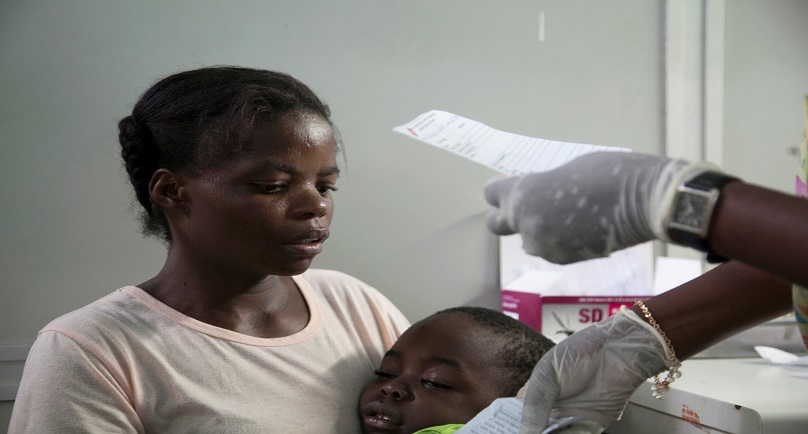Image: A mother holds her son suffering from yellow fever as she waits for a prescription at a hospital in Luanda?, Angola, March 15, 2016. REUTERS/Herculano Coroado
By Ed Cropley
LUANDA (Reuters) – The world’s worst yellow fever outbreak in decades took hold in an Angolan slum because its early victims were Eritrean migrants whose false vaccination papers sent doctors off on the wrong path for weeks, international health officials said.
The flare-up of the mosquito-borne disease has killed 325 people in Angola, spread as far as China – which has close commercial links with oil-rich Angola – and raised fears of the world running out of vaccine, but it might have been stopped in its tracks if it had been identified quickly in Luanda.
Since the outbreak was identified in January, 10.5 million Angolans – 40 percent of the population – have been vaccinated and the World Health Organization (WHO) plans to cover the rest of the war-scarred country by the end of the year.
But with a reported case this week of the disease jumping via a mosquito from one person to another in Kinshasa, a city of over 12 million in neighboring Democratic Republic of Congo, there are concerns about global vaccine supplies running out.
Luanda WHO representative Hernando Agudelo said he and government experts thought they were dealing with a mystery disease when unexplained deaths first surfaced in Km 30, part of the capital’s sprawling Viana district, in mid-December.
“The first people that we found with this strange way of dying, this syndrome, they had vaccination cards,” Agudelo told Reuters. “The first meeting with the minister, we were analyzing ‘What the hell is it?'”
Yellow fever is transmitted by the same mosquitoes that spread the Zika and dengue viruses, although it is much more serious with death rates as high as 75 percent in severe cases requiring admission to hospital.
The condition takes its name from the jaundiced color of some patients.
With the devastating West African Ebola outbreak in the back of their minds, Angolan and WHO investigators quickly nailed down a restaurant in Km 30, home to the biggest informal market in the city of 7 million, as the link between the victims.
“We started to look at what they had in common and they were from Eritrea,” Agudelo said. “All of them had passed through the same restaurant.”
Most people fleeing rigidly controlled Eritrea in the Horn of Africa try to get into Europe, although a few head to other African countries such as Angola, which denies entry to anybody without vaccination documents.
When the restaurant owner also died, samples were sent to South Africa’s National Institute of Communicable Diseases, where technicians who had been told about the vaccination papers only ran a yellow fever test “by chance”, Agudelo said.
The lab confirmed yellow fever on Jan. 19, according to the WHO.
But by this point, the outbreak had long since spread from Viana, and by February suspected cases were recorded in more than half of Angola’s 18 provinces. In April, victims who contracted it in Angola were dying in Congo.
CHOLERA, TYPHOID, PLAGUE
The outbreak has been a brutal wake-up call for Angola, currently Africa’s biggest oil producer and, until recently, one of its brightest investment prospects.
The economy has grown rapidly since the end of a 27-year civil war in 2002 as billions of dollars have been ploughed into reconstruction, although the government has been criticized for failing to make similar investments in education and health.
Routine yellow fever vaccination, which only started in the late 1980s, still reaches only 70 percent of the population, said Francisco Sondane, a medical doctor running Angola’s UNICEF operations who confirmed Agudelo’s account of the Eritreans.
Nearly the whole of Luanda has now been vaccinated, but the mass campaign across the rest of the country has depleted the world’s emergency vaccine stockpile and there is no quick way to boost production.
Manufacturers, including the Institut Pasteur, government factories in Brazil and Russia, and French drugmaker Sanofi, use a time-consuming method involving sterile chicken eggs.
Should the disease take hold in Kinshasa, one of Africa’s biggest cities, health officials may have little option but to stretch out the global stockpile of 6 million shots by administering one-fifth doses.
In Luanda, health officials are ruing the missed early opportunities and the massive cost that has now entailed.
“If we had contained this at the Luanda level, we would not have had to spend the money that we’re spending now,” said Francisco Sondane, a medical doctor running UNICEF’s operations in Angola.
Nor may yellow fever be the only public health emergency Angola has to tackle.
The collapse in oil revenues has hammered the government budget – 70 percent of which normally comes from petroleum receipts – to the point that basic services such as garbage collection in the capital have ground to a halt.
Mounds of rubbish lie rotting on street corners, a breeding ground for pests such as flies and rats and, in the rainy season, mosquitoes. Many roads – even in the shadow of glittering skyscrapers – reek of sewage.
Nearly 3,000 people died of malaria in the first three months of this year, compared to 8,000 in the whole of 2015, according to the WHO, and outbreaks of diseases such as cholera, typhoid or plague are not out of the question, Sondane said.
“The situation with the garbage is really bad,” he said. “Now we’re grappling with yellow fever, but others will come.”
(Reporting by Ed Cropley)
Copyright 2016 Thomson Reuters. Click for Restrictions.


